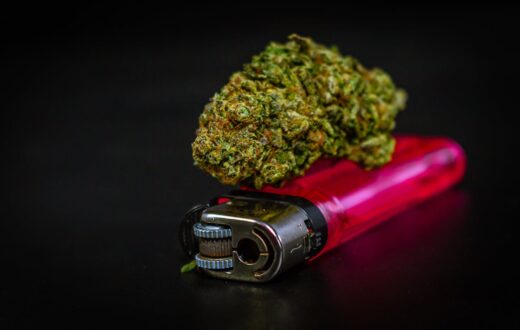Introduction to Big Bud Weed Strain
The Big Bud weed strain is renowned within the cannabis cultivating community for its remarkable yields and robust characteristics. Originating from a cross of Afghani and Skunk strains, Big Bud is an indica-dominant hybrid that combines the best traits of its parent strains. This genetic background provides growers with a plant that is not only hardy but also capable of producing substantial buds that boast impressive THC content.
Historically, Big Bud has gained popularity since its inception in the 1980s, making a significant impact on the cannabis market due to its potency and ease of cultivation. The strain was bred specifically to produce larger buds than other strains, which is reflected in its name and reputation. Cultivators favor Big Bud not only for its size but also for its high yield potential, making it an economical choice for both novice and experienced growers alike.
Aromatically, the Big Bud weed strain presents a delightful blend of sweet and earthy notes, enhanced by subtle hints of spiciness. When smoked, it offers a rich flavor profile that resonates with its aroma, delivering a smooth and satisfying experience that appeals to many cannabis enthusiasts. The effects of Big Bud are often characterized by deep relaxation and mild euphoria, making it a popular choice among those seeking relief from stress and discomfort.
In addition to its desirable qualities, Big Bud is relatively easy to grow. It can thrive indoors and outdoors, making it adaptable to various growing environments. The strain also exhibits resistance to common pests and mold, reducing maintenance challenges for growers. For anyone looking to cultivate cannabis that maximizes yield without sacrificing quality, understanding how to grow Big Bud weed strain could be a pivotal step in their growing journey.
Optimal Growing Conditions
Successfully cultivating the Big Bud weed strain necessitates creating the right environment, as this particular strain thrives under specific conditions. First and foremost, the climate plays a crucial role; Big Bud flourishes in a warm, moderate climate. Ideal outdoor environments typically feature average temperatures ranging from 70 to 80 degrees Fahrenheit during the daytime. If growing indoors, maintaining a consistent temperature that aligns with these figures contributes significantly to the plant’s overall health.
Humidity is another essential factor to consider. Big Bud benefits from a humidity level of around 40% to 50% during the vegetative stage, which supports healthy growth. As plants transition into the flowering phase, lowering humidity to about 30% is advisable. This reduction helps avoid issues such as mold and mildew, which can devastate both yield and quality. Using dehumidifiers or humidifiers can assist in adjusting the humidity levels appropriately.
Moreover, light exposure is critical in promoting robust growth. Big Bud cannabis plants require ample light for photosynthesis, with a preference for full sun outdoors or strong artificial lighting indoors. In an indoor setup, utilizing high-intensity discharge (HID) lights or light-emitting diodes (LEDs) that provide a spectrum conducive to growth is recommended. Ensuring that plants receive 18 hours of light during the vegetative stage and reducing it to 12 hours during flowering will significantly enhance yields.
Ultimately, providing the optimal growing conditions, such as the right climate, temperature, humidity, and light, is essential for the Big Bud strain. By paying close attention to these variables and making adjustments as necessary, growers can effectively maximize growth and yield, leading to a more successful cultivation experience.
Soil and Nutrients for Big Bud
To successfully cultivate the Big Bud weed strain, selecting the right soil and nutrients is paramount. The optimal soil mix typically consists of a well-aerated medium that contains a blend of organic matter, peat moss, and perlite. This combination allows for excellent drainage while retaining sufficient moisture. Furthermore, a pH level between 6.0 and 7.0 is essential for facilitating nutrient uptake. Growers often prefer fortified organic soils as they provide a natural source of nutrients while promoting beneficial microbial activity, crucial for healthy root development.
When it comes to nutrients, understanding the needs of Big Bud at different growth stages ensures a bountiful yield. During the vegetative stage, the plants require higher levels of nitrogen for vigorous growth. Conversely, in the flowering stage, phosphorus and potassium become vital to enhance bud formation and overall potency. While both organic and synthetic nutrients can be employed, many growers lean towards organic options to cultivate a cleaner product. Organic nutrients, derived from natural sources, tend to release more gradually and foster a balanced soil ecosystem, whereas synthetic options offer immediate availability but may lead to nutrient lockout if not managed carefully.
Nutrient schedules play a critical role in ensuring appropriate feeding regimens. Many cultivators follow a diluted nutrient solution throughout the different growth phases, adjusting concentrations as the plants mature. Additionally, supplementation with micronutrients can provide an extra boost, specifically calcium and magnesium, which are crucial for cell structure and photosynthesis. Regular monitoring through pH testing and observing plant responses can guide growers in fine-tuning their approach, maximizing the health and yield of Big Bud. By utilizing the right soil mix and nutrient strategy, achieving a successful grow with this strain becomes a feasible task for both novice and experienced cultivators alike.
Choosing the Right Growing Method
When considering how to grow Big Bud weed strain, one of the most crucial decisions is selecting the appropriate growing method. There are three primary methods: indoor, outdoor, and greenhouse cultivation, each with its own set of advantages and disadvantages, which can significantly impact the growth and yield of the plants.
Indoor cultivation is often favored by those seeking more control over environmental conditions. This method allows growers to regulate temperature, humidity, and light exposure, which can lead to higher potency and enhanced bud quality. However, the initial setup costs for indoor cultivation can be high, as it requires equipment such as grow lights, ventilation systems, and climate control devices. Additionally, growers will need to manage electricity costs and may face space limitations.
On the other hand, outdoor growing is a more natural approach that can yield exceptionally high quantities of produce, especially ideal for growing the Big Bud strain, known for its large buds. Outdoor cultivation allows plants to benefit from natural sunlight and open air, which can enhance flavor and aroma. However, growers must contend with environmental factors like pests, weather conditions, and seasonal changes that may adversely affect the plants. Moreover, outdoor growing can be limited by climate; some regions may not provide the optimal conditions for this strain.
Alternatively, greenhouse cultivation offers a hybrid solution, blending the benefits of both indoor and outdoor growing. Greenhouses provide a controlled environment while still allowing plants to harness sunlight. This method protects against pests and unpredictable weather while enabling growers to extend their growing season. However, the initial construction and maintenance of a greenhouse can be pricey.
Ultimately, the choice of growing method will depend on personal preference, available resources, and specific goals for cultivating the Big Bud weed strain. Each method presents unique challenges and benefits that growers should carefully consider.
Pruning and Training Techniques
To cultivate the Big Bud weed strain successfully, it is paramount to implement effective pruning and training techniques. These methods can significantly enhance the overall growth, improve light penetration, and encourage optimal airflow, which ultimately leads to larger yields.
Topping is one such technique that involves cutting off the top of the main stem once the plant has developed several nodes. This encourages the plant to redirect its energy toward the lower branches, allowing them to grow more vigorously. For those wondering how to grow Big Bud weed strain to its fullest potential, employing topping can effectively increase the number of colas, resulting in a bushier plant with more flowering sites.
Low-stress training (LST) is another valuable technique. This method involves gently bending and tying down branches to promote horizontal growth. By doing so, more nodes are exposed to light, which can improve yield. When you train the Big Bud strain using LST, it capitalizes on its natural growth tendencies while ensuring that the plant receives adequate light without causing undue stress. It makes for a more manageable height and encourages branching, supporting thicker foliage.
ScrOG, or Screen of Green, is an advanced training method that utilizes a screen placed above the plants. As the Big Bud weed strain grows, the stems are woven through the screen, ensuring that every bud site has ample light exposure. This increases air circulation around the plant, minimizing the risk of mold and disease while promoting healthy growth. Integrating this technique will significantly influence how to grow Big Bud weed strains effectively, as it maximizes space and yield potential.
By utilizing these pruning and training techniques—topping, low-stress training, and ScrOG—cultivators can enhance the growth environment for the Big Bud weed strain. This strategic approach fosters healthier plants and maximizes the potential for larger yields, ensuring that growers can achieve optimal results from their efforts.
Pest and Disease Management
Managing pests and diseases is crucial when cultivating the Big Bud weed strain, as any infestation or illness can significantly affect plant health and yield. Identifying common pests is the first step towards effective management. Aphids, spider mites, and whiteflies are frequent nuisances for cannabis growers. Monitoring your plants regularly allows you to catch these pests early before they proliferate. Look for signs such as yellowing leaves or webbing, which can indicate spider mite activity.
Alongside pests, various diseases can afflict Big Bud plants, including powdery mildew and root rot. The moist climate often exacerbates these issues, so ensuring proper airflow and avoiding overcrowded growing conditions is essential. Powdery mildew typically appears as white, powdery spots on the leaves, while root rot manifests through wilting and stunted growth. Preventive measures such as maintaining optimal humidity levels and ensuring adequate drainage can reduce the likelihood of these diseases occurring.
When it comes to controlling pests and diseases, both organic and chemical options are available. Organic methods, such as insecticidal soaps and neem oil, work effectively against common pests while being environmentally friendly. However, chemical pesticides can also be employed, provided they are used judiciously and in compliance with local regulations, as they can be harmful to beneficial insects and the surrounding ecosystem. Whichever method you choose, it is important to follow the manufacturer’s instructions carefully to avoid damaging your plants.
In conclusion, diligent monitoring and prompt intervention are essential in the management of pests and diseases affecting the Big Bud weed strain. By employing both preventive measures and effective control methods, growers can achieve a healthy environment for their plants, ultimately leading to a successful harvest.
Harvesting Techniques for Maximum Yield
Successfully harvesting the Big Bud weed strain requires careful monitoring and the implementation of effective techniques. The timing of the harvest is crucial for ensuring maximum potency and yield. It is essential to observe the trichomes—tiny, resinous glands on the buds—using a magnifying glass or jewelers’ loupe. Buds should typically be harvested when approximately 70-80% of the trichomes have turned from clear to a milky white or cloudy appearance. Some growers may prefer to wait for a few amber-colored trichomes to appear, as this builds potency and indicates the optimal time for harvesting.
Once the appropriate harvesting time has been determined, it is important to employ efficient harvesting techniques to minimize damage to the plant. Start by preparing your tools, such as sharp scissors or shears, to ensure clean cuts. Gently twist or cut the branches, taking care not to damage the neighboring buds. It is advisable to work in a cool and dry environment to preserve the quality of the harvested product. After cutting the branches, hang them upside down in a controlled climate, ideally at a temperature of about 60-70°F with 50% humidity, to allow for proper drying. This process typically takes around 7 to 14 days, depending on environmental conditions.
Following the drying phase, trimming the buds is the next critical step. It is advisable to remove excess leaves, focusing on the sugar leaves that are covered in trichomes and contribute to overall flavor and potency. Proper trimming not only enhances the aesthetic appeal but also allows better airflow during the curing process. Curing is vital for developing the full flavor profile of the Big Bud weed strain. Store the trimmed buds in airtight containers, opening the jars periodically to let moisture escape and to refresh them. This careful process will ensure that your Big Bud strain reaches its maximum potential in flavor and effects.
Potential Challenges and Solutions
Growing the Big Bud weed strain offers immense rewards, yet numerous challenges may arise during the cultivation process. Understanding these obstacles and having strategies at hand to tackle them can significantly enhance the success of your growing endeavor. Common challenges include environmental stressors, nutrient deficiencies, and pest infestations, each of which can hinder the growth and yield of the plant.
Environmental stressors, including temperature fluctuations and humidity levels, can have detrimental effects on the Big Bud strain, which thrives in a stable and controlled environment. Maintaining temperatures between 70°F to 85°F during the day and ensuring humidity levels remain around 40% to 50% can mitigate these issues. Utilizing tools such as thermometers and hygrometers enables precise monitoring of these conditions, allowing for timely adjustments. Additionally, employing air circulation systems can help maintain a consistent environment and prevent mold growth, particularly during the flowering stage.
Nutrient deficiencies are another common challenge when cultivating Big Bud weed strain. This strain has high nutrient demands due to its robust growth and large buds. Growers should regularly test the soil and water to monitor nutrient levels, employing fertilizers specifically designed for cannabis cultivation. Identifying symptoms of deficiencies, such as yellowing leaves or stunted growth, allows for quick intervention. Balanced nutrients, including nitrogen, phosphorus, and potassium, are vital throughout the different growth phases, from vegetative to flowering.
Pest infestations can also pose a significant threat, as pests like aphids and spider mites are notorious for damaging cannabis plants. Preventative measures, such as maintaining cleanliness in the grow area and regularly inspecting plants can thwart infestations before they escalate. In the event of an outbreak, organic pesticides can be effective without harming the plant’s natural growth. Employing integrated pest management (IPM) strategies will enable you to manage pest populations while minimizing chemical exposure.
By proactively addressing these potential challenges, growers can optimize the conditions for cultivating the Big Bud weed strain, leading to a successful and bountiful harvest.
Conclusion and Final Thoughts
In conclusion, cultivating the Big Bud weed strain can be a rewarding endeavor for both novice and experienced growers. Throughout this guide, we have explored the essential techniques and best practices on how to grow Big Bud weed strain successfully. From understanding its distinct characteristics to ensuring optimal environmental conditions, each step is vital in achieving a fruitful yield. The Big Bud strain is renowned for its impressive flowering and dense buds, making it a preferred choice among cannabis cultivators.
One of the key takeaways is the importance of maintaining appropriate growing conditions, which directly influence the health and productivity of the plants. This includes regulating temperature, humidity, and light exposure. Additionally, understanding the nutritional requirements of the Big Bud strain allows growers to provide adequate fertilizers and amendments, ultimately boosting the plants’ growth and potency.
Moreover, experimenting with various training techniques such as topping, pruning, and low-stress training can significantly enhance yields. These methods promote better light penetration and airflow, fostering a more robust plant structure. As you implement these strategies, documenting your growth journey can contribute to a wider knowledge base within the cannabis community.
Encouraging communication among growers can lead to shared insights and improvements on how to grow Big Bud weed strain effectively. Participating in forums and local growing groups will not only enrich your understanding but also create a supportive network where you can exchange experiences and tips. Ultimately, the process of cultivation can be as fulfilling as the results, as it allows growers to connect with their plants and the broader cannabis culture. Embrace the journey, and enjoy the fruits of your labor.














